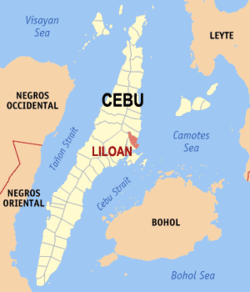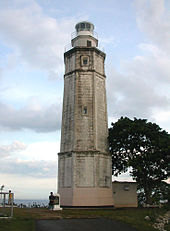Liloan
Liloan | |
|---|---|
 From Suba bridge | |
| Nickname: The Light of the North | |
| Motto: Abante Lilo-an! | |
 Map of Cebu with Liloan highlighted | |
| Country | Philippines |
| Region | Central Visayas (Region VII) |
| Province | Cebu |
| District | 5th District of Cebu |
| Founded | 1845 |
| Barangay | 14 (see § Barangays) |
| Government | |
| • Type | Sangguniang Bayan |
| • Mayor | Christine Frasco (1‑Cebu) |
| • Vice mayor | Duke Frasco |
| • Municipal Council | Members |
| • Representative | Red Durano |
| Area | |
| • Total | 45.92 km2 (17.73 sq mi) |
| Population (2020 census)[3] | |
| • Total | 153,197 |
| • Density | 3,300/km2 (8,600/sq mi) |
| • Voter (2022)[4] | 82,428 |
| • Language | Cebuano Tagalog |
| Time zone | UTC+8 (PST) |
| ZIP code | 6002 |
| IDD : area code | +63 (0)32 |
| Income class | 1st class, partly urban |
| PSGC | 072227000 |
| Website | www |
Liloan (also spelled Lilo‑an) is a [[Template:PH plural of the Philippines#Income classification|1st municipal income class municipality]] in the province of Cebu, Philippines. According to the 2020 census, it has a population of 153,197.[3] Template:PH electorate
Liloan lies within Metro Cebu.
History
Along its coastline, there is spot called Silot, where a whirlpool is created by the ebbs and flows of the waters from the bay. This phenomenon is called lilo in Cebuano. Because of this, the town was known as Liloan, meaning "a place where there is a lilo".
Some time in the 1970s, a newspaper article stated that the "pueblo de Lilo‑an" was separated from the municipality of Mandaue (now Mandaue City), and was created a new municipality in 1840. However, in his "Breve reseña de lo que fue y de lo que es la Diócesis de Cebú en las Islas Filipinas," Redondo (1886) states that Lilo‑an was created as a parish in 1845 (in 1995, Lilo‑an celebrated its sesquicentennial - 150th – anniversary.)
The creation of the municipality of Lilo‑an could have been at the same time the parish was established, but not earlier than its being a parish. As recorded, the first priest of Lilo‑an served in 1845. The term of the first mayor was from 1845–1846.
During the war years (World War II), Lilo‑an had three mayors at one time. The elected mayor was Catalino Noval. The Japanese Occupation Forces appointed another, Pascual Delgado. Not to be outdone, the Guerilla Forces also designated another, Jose Cañete.
Barangays
Liloan comprises 14 barangays:[2]
| PSGC | Barangay | Population | ±% p.a. | |||
|---|---|---|---|---|---|---|
| 2020[3] | 2010[5] | |||||
| 072227001 | Cabadiangan | 1.3% | 1,982 | 1,790 | 1.02% | |
| 072227002 | Calero | 3.5% | 5,315 | 4,513 | 1.65% | |
| 072227003 | Catarman | 10.3% | 15,829 | 14,839 | 0.65% | |
| 072227004 | Cotcot | 4.4% | 6,796 | 5,185 | 2.74% | |
| 072227005 | Jubay | 7.8% | 11,931 | 8,819 | 3.07% | |
| 072227006 | Lataban | 1.5% | 2,245 | 1,863 | 1.88% | |
| 072227007 | Mulao | 0.7% | 1,067 | 952 | 1.15% | |
| 072227008 | Poblacion | 9.8% | 15,041 | 13,371 | 1.18% | |
| 072227009 | San Roque | 1.0% | 1,521 | 1,331 | 1.34% | |
| 072227010 | San Vicente | 6.7% | 10,219 | 8,665 | 1.66% | |
| 072227011 | Santa Cruz | 1.4% | 2,203 | 1,899 | 1.50% | |
| 072227012 | Tabla | 0.9% | 1,423 | 1,189 | 1.81% | |
| 072227013 | Tayud | 10.3% | 15,814 | 13,616 | 1.51% | |
| 072227014 | Yati | 17.9% | 27,367 | 22,468 | 1.99% | |
| Total | 153,197 | 100,500 | 4.30% | |||
Demographics
|
| ||||||||||||||||||||||||||||||
| Source: Philippine Statistics Office[6][5][7][8] | |||||||||||||||||||||||||||||||
Landmarks

Lighthouse
One of the best known landmarks in Lilo‑an is its historic lighthouse at Bagacay Point. The original lighthouse was built in 1857 by the Spanish. The current tower was constructed in 1904 by order of William Howard Taft,[9] the first Governor-General of the Philippines and later the President of the United States. The tower is 22 metres (72 ft)* tall and remains in active use today, using solar energy.[10] The lighthouse was declared a National Historical Landmark in 2004 by the National Historical Commission of the Philippines (formerly known as National Historical Institute).[11]
Liloan Church (San Fernando Rey Parish Church)

The designer of the church in Liloan is viewed by some as visionary. Despite Liloan having only 5,000 citizens, when the church was constructed in 1847, this local church was even larger than that of Mandaue, Cebu's second largest city.
One unusual detail about the church in Liloan is that it faces the mountains to the west, whereas most churches face the sea to the east. Some have theorized that this is because Mass is often performed in the morning; and the church is thus shielded from the morning sun, making it less hot and uncomfortable. Others have speculated that the church's direction has a symbolic significance related to church rites.
Titay's Rosquillos and Delicacies
The making of these little ringlet cookies dates back to 1907, when 21-year-old Margarita "Titay" Frasco was tinkering in her kitchen with her baking ingredients and made her new culinary creation. Kneading the dough manually and using a wooden eggbeater, some baking tins and a clay oven, she started a product that would put her little town in the national and international map of gastronomic delight.
The market for her unnamed cookie started with her neighbors and passers-by who were offered the snack with a bottle of soda. It was Sergio Osmeña (then Cebu governor, who later became Philippine president), who gave it the name "rosquillos" after the Spanish word rosca.
The biscuits have been a regular stopover of tourists and locals travelling north of Cebu. The company has withstood the taste of time. It started with just rosquillos and tablea making.[a] It later expanded to an array of homemade delicacies including torta, mamon, monay, otap, CPA (chicken pork adobo), bao-bao and more.
- Rosquillos Festival
Celebrated every last week of May in honor of the town's patron saint, St. Ferdinand III. Rosquillos have become a household name, a product that is aptly celebrated in a festival that Liloan could call its very own.
Economy
Liloan is home to a number of ceramics manufacturers. Their shops sell a variety of ceramic items: from ordinary plant pots, to bricks and exotic jars.
Notes
- ^ pure cacao beans that are dried, roasted, ground and then formed into tablets
References
- ^ Municipality of Liloan | (DILG)
- ^ a b "Municipal: Liloan". PSGC Interactive. Quezon City, Philippines: Philippine Statistics Authority. Retrieved 8 January 2016.
- ^ a b c Census of Population (2020). "Region VII (Central Visayas)". Total Population by Province, City, Municipality and Barangay. Philippine Statistics Authority. Retrieved 8 July 2021.
- ^ "Number of Registered Voters by Sex : 2019 National and Local Elections" (PDF). Commission on Elections. 2019.
- ^ a b Census of Population and Housing (2010). "Region VII (Central Visayas)" (PDF). Total Population by Province, City, Municipality and Barangay. National Statistics Office. Retrieved 29 June 2016.
- ^ Census of Population (2015). "Region VII (Central Visayas)". Total Population by Province, City, Municipality and Barangay. Philippine Statistics Authority. Retrieved 20 June 2016.
- ^ Censuses of Population (1903–2007). "Region VII (Central Visayas)". Table 1. Population Enumerated in Various Censuses by Province/Highly Urbanized City: 1903 to 2007. National Statistics Office.
- ^ Gonzales 2004.
- ^ Philippines' Light to Get Makeover
- ^ Bagacay Point Light
- ^ Declaring of Bagacay Point Lighthouse in Liloan, Cebu a National Historical Landmark
Sources
- Gonzales, Glenda R. (December 2004). "Metro Cebu: A Metropolitan Area in Need of Coordinative Body" (PDF). DISCUSSION PAPER. 2004-49. Philippine Institute for Development Studies. Retrieved 16 February 2016.
{{cite journal}}: Invalid|ref=harv(help) - Sendino y Redondo, Felipe (1886). Breve reseña de lo que fue y de lo que es la Diócesis de Cebú en las Islas Filipinas (in Spanish). Manila: Colegio de Sto. Tomas.
